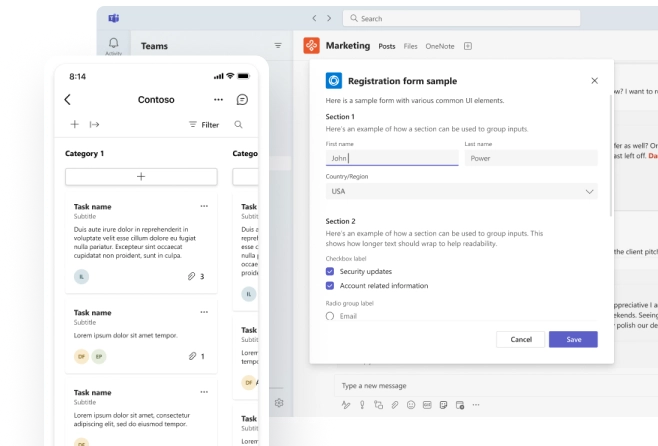If you’ve got a talkative organisation, you’ll love the productivity gains everyone gets from expanding your Teams calling capabilities. Here are some of our favourite advantages it brings.
Microsoft Teams Direct Routing Partner | UK based expert MSP
Your Microsoft Teams Direct Routing Partner

Imagine being able to call people directly from your contact list, integrated with your CRM, with a single platform for collaboration, audio/video calls, file sharing, and more.
With cheaper calls, more flexibility, and better productivity, too.
No more switching between multiple applications or services, no more clumsy integrations. You’d be mad not to.
This is the magic of Microsoft Teams Direct Routing. It’s a cloud-based, cost-effective alternative to traditional PBX telephone systems that could revolutionise the way you communicate. Here’s how this future-ready business phone system works.

Direct Routing is a nifty bit of tech that connects Microsoft Teams to the public switched telephone network (PSTN). It’s a way of hooking things up that connects your Teams users to the outside world, allowing them to make and receive external calls right from the Teams platform. No more wrestling with a separate PBX, no more need for physical desk phones, it’s VoIP functionality at its finest. All the functionality is right there, housed neatly within your existing Office 365 setup.
A Microsoft Direct Routing solution is a cost-effective alternative to Microsoft Calling Plans, and is a great way to bring together your telecoms and conferencing in one unified communications system. All it needs is a reliable internet connection, and you’re ready to go. Direct Routing turns Teams into an enterprise-grade telephony solution, which we think is a pretty smart way of doing things.
The benefits of Direct Routing
for Microsoft Teams
Simplifies your comms system
Managing one phone system instead of juggling multiple? Now that’s what we call a game-changer. With Direct Routing, everything’s centralised in one place, from your call routing to your instant messaging.
No need for a desk phone
Forget about clunky handsets. With Direct Routing, your device – whether that’s a computer or a mobile – becomes your phone. Perfect for remote working and hotdesking, users’ phone calls can be made through a regular headset or pair of headphones.

Fits in with your existing setup
The Teams phone system is available as an add-on for existing Microsoft Teams installations. It’s a bolt-on solution, so you don’t have to reconfigure all your accounts and hardware. As long as you have a Microsoft Phone System licence as part of Office 365, it can work for you.

Better customer experience
Manage customer interactions more efficiently and transform your Teams into a contact centre. Your MS Teams users will be able to serve customers more quickly and effectively than before, with conversation history and customer information right in front of them.
High availability and reliability
Enterprise-grade telephony means high-quality voice calls, conferencing, and the peace of mind that comes with a reliable, managed service.
Simple pay structure
Direct Routing means clear, straightforward pricing. No hidden costs, no unwelcome surprises, just cost savings and transparency. You can choose your own telephony provider so you can get the best rates – you’re not stuck with Microsoft’s pre-set calling plans. And you don’t have to pay for hardware up-front, so it’s OpEx not CapEx.
Number porting
You can easily bring your existing phone numbers with you. No need to update directories and reprint your brochures. Your ability to take inbound calls won’t be affected.

Microsoft Teams Direct Routing essentially bridges your existing PBX system, whether it’s on-premise or in the cloud, to Microsoft Teams, turning Teams into the hub for all your voice communications.
Here’s how it works in a nutshell:
- Session Border Controllers (SBCs) are the border guards between VoIP networks. They mediate between your telecom infrastructure and the Microsoft Phone System, ensuring secure and smooth voice connections. A bit like a firewall, they were traditionally physical on-site devices, but these days are usually part of a cloud solution.
- The SBC connects to a SIP Trunk, a link between your PBX, the internet, and the public phone network (PSTN). The modern way to connect business phone networks over the internet.
- With the SBC and SIP Trunk in place, your Microsoft Teams platform can then handle all your voice traffic. This means you can use Teams just like a traditional phone system, making, receiving, and transferring calls seamlessly alongside all other Teams functions.
By activating Microsoft Teams Direct Routing, you’re enabling Teams to handle all voice traffic via the PBX, resulting in an integrated, easy-to-manage communications solution.

The Synextra difference
So that’s our ringing endorsement of Microsoft Teams Direct Routing. A streamlined, efficient, and cost-effective communications solution that could be a game-changer for your business.
No more wrestling with spaghetti wiring and confusing phonebooks; just straightforward, unified communications. What’s not to love?
Does your team use Teams a lot? Do you make a lot of outbound calls? Do you need more flexibility than Microsoft Calling?
It could be a brilliant option for you – and at Synextra, we’re committed to making Direct Routing work for you.
As a cloud computing consultancy, we’ve got years of experience under our belt in helping companies bring their tech into the modern era. We love seeing organisations thrive through digital transformation of all kinds.
So why not explore what a Direct Routing service can do for your business? Give us a call and we’ll get you talking.
out more



